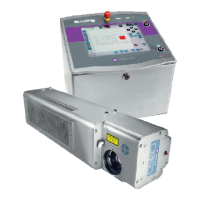Safety
A70622-D1
14/192
■ Eye protection
Since the CO2 laser beam is very strongly absorbed by water, the cornea and the
sclerotic coat are the main parts of the eye which are at risk from damage. They can
suffer irreversible defects and permanent scarring following direct or indirect exposure
to a CO2 laser beam. The severity of the damage to these parts of the eye depends on
the level of concentration or diffusion in the beam and on exposure time.
IMPORTANT:
Permanent eye damage can be caused if the laser radiation enters the eyeballs
directly or by reflection from a metal surface during procedures requiring access
to the laser emitter.
People must wear protective goggles suitable for use with carbon dioxide lasers
when using Class IV lasers.
Anyone not wearing appropriate eye protection must be kept out of the area or
room where the laser equipment is located.
The following precautions only apply to protection against CO2 laser radiation, with
wavelengths between 9.3 and 11.5 µm (microns):
All people working in the area where the laser equipment is operated must wear
protective goggles with side shields for use with CO2 laser radiation.
Plastic prescription glasses may only be used instead of goggles at the user's risk,
as they do not have protective side shields. N.B.: Glass can be shattered by a high-
power laser beam.
Contact lenses and half-moon reading glasses never provide sufficient protection.
Glazing providing protection against CO2 radiation generally protects people
passing behind the glass.
Never look directly at the carbon dioxide laser light source or at a laser light which
has been diffused on reflective surfaces.
The working area must be isolated by means of metal, acrylic or polycarbonate
panelling and have a lockable safety door.
The laser system must be de-activated automatically by an interlock system when
the safety door is opened. The door interlock circuit must be designed or
configured so that the operator is forced to take action before the circuit is re-
activated after the operator has opened and then closed the door.

